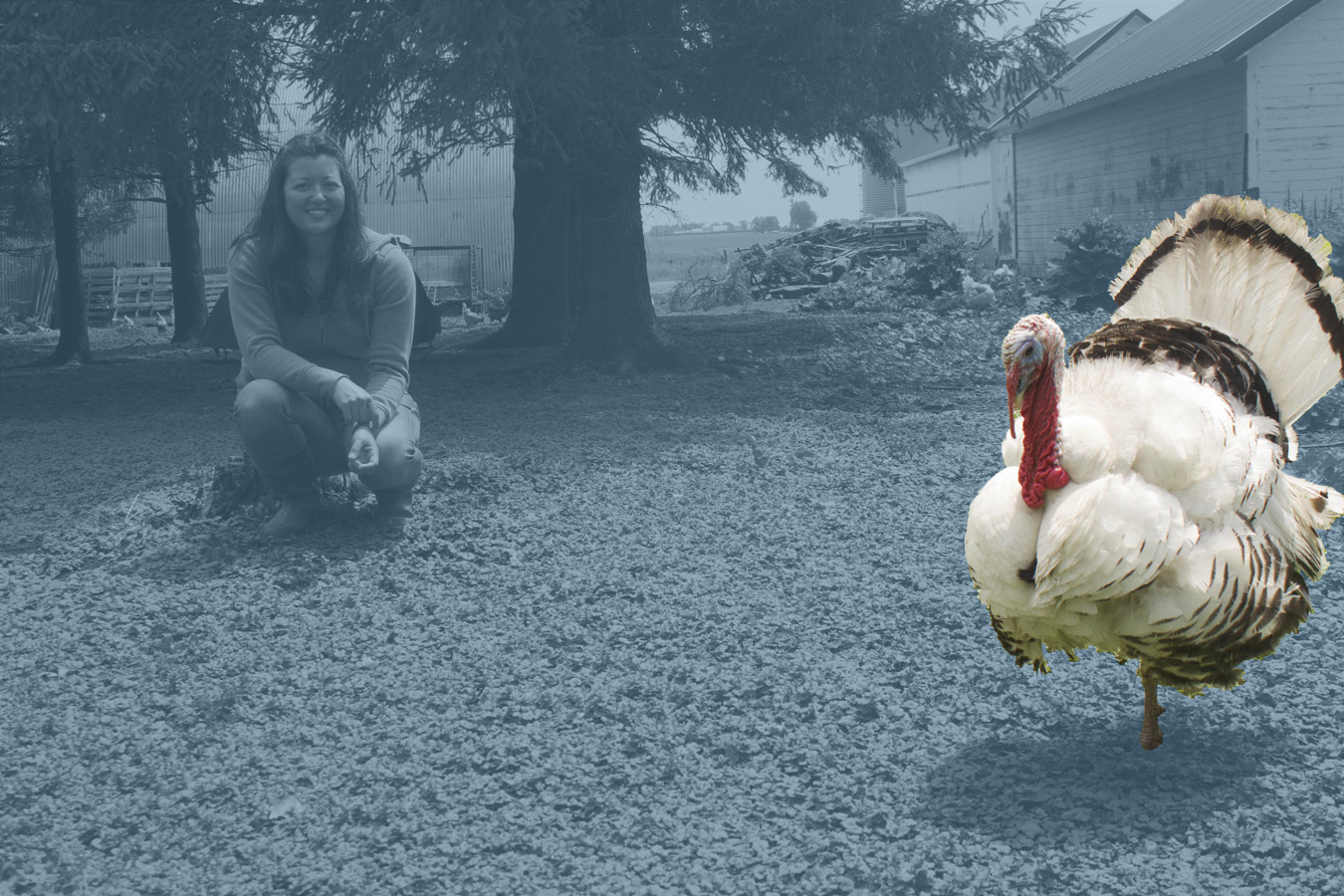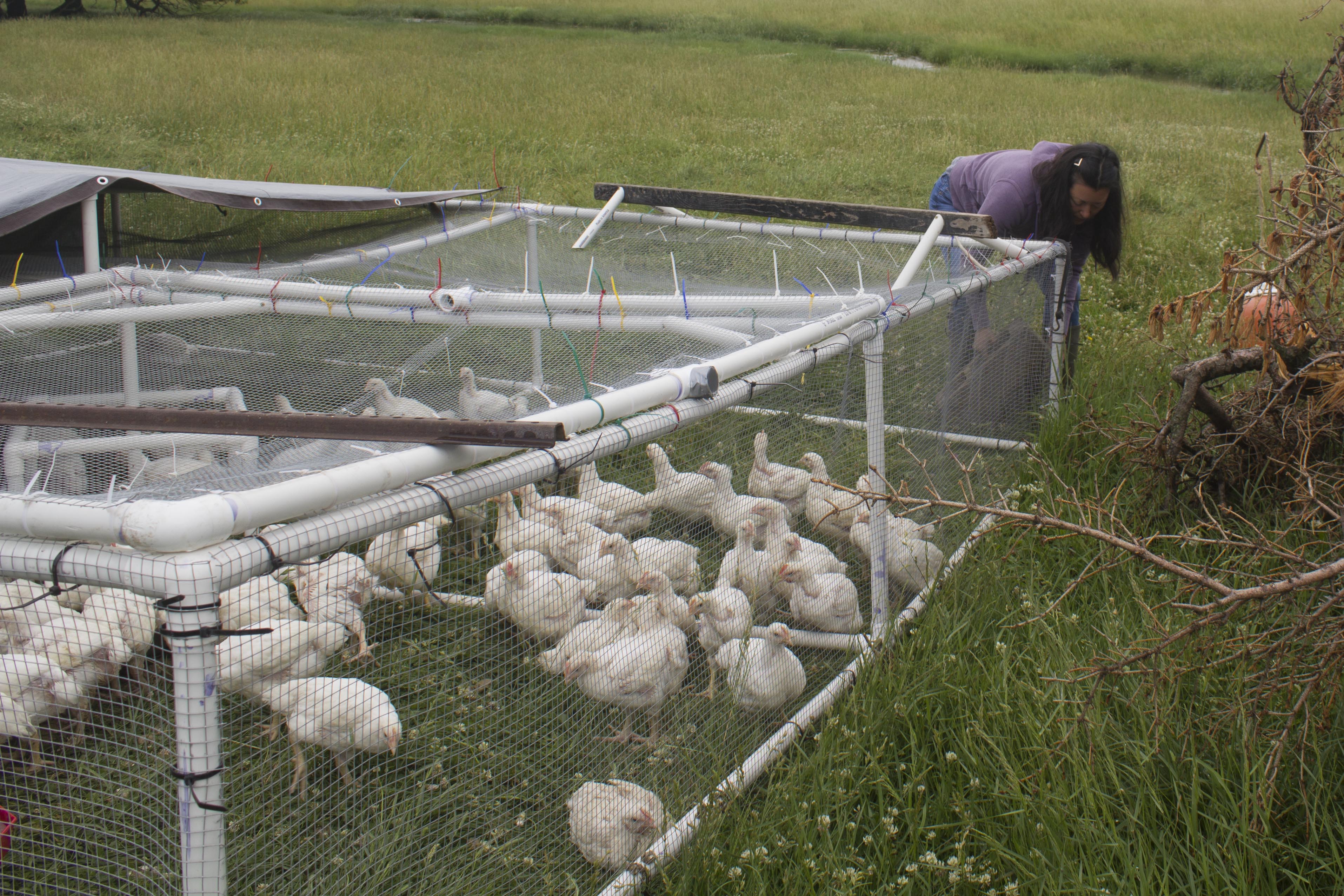For Farmers, Rotating Livestock Pays Off
4:30 minutes

This segment is part of The State of Science, a series featuring science stories from public radio stations across the United States. This story originally appeared on Harvest Public Media.
On a cloudy summer day, Iowa farmer Wendy Johnson lifts the corner of a mobile chicken tractor, a lightweight plastic frame covered in wire mesh that has corralled her month-old meat chickens for a few days, and frees several dozen birds to peck the surrounding area at will. Soon, she’ll sell these chickens to customers at local markets in eastern Iowa.
The demand for beef, pork and chicken raised on smaller farms closer to home is growing. Now, some Midwest farmers, like Johnson, are exploring how to graze livestock to meet those demands while still earning a profit.
Johnson runs Joia Food Farm on land she rents from her family, which has a conventional corn and soybean operation near Charles City, Iowa. She transitioned some fields to organic for corn and soybeans but also raises several types of livestock.
[How are farmers reinventing themselves for climate change? ]
“Before we just let them out and day range, we make sure they know and understand that this is their home,” Johnson says, “so they go back into it.”
From now on, the chickens will be free to forage and peck the surrounding area during the day. The portable coop will keep them safe at night.
“I have watched them eat, they really love the tips of the new grass,” Johnson says, “and the white clover flowers.”
Most of the meat in grocery stores comes from huge farms and ranches that gain efficiency through economies of scale, and bring us cheap burgers, chops and wings. Those farms can be rough on the environment, generating massive amounts of animal waste and depleting the soil. Johnson’s approach relies on grazing different types of animals on the same land in a carefully controlled pattern, which ideally will enhance the land they roam. When used with several different animals, the technique is sometimes called multi-species grazing.
Johnson plans to rotate sheep through a series of small paddocks, followed by the meat chickens. The animals will eat what they please and fertilize with their waste. Laying hens and turkeys roam freely about her farm and yard. And she plans for pigs to eventually graze on organic crop fields where their natural rooting behavior should help improve soil health.
[Is healthy soil the low-tech solution to climate change? ]

Farmers like Johnson are hoping creative approaches to providing meat, often at a premium, to customers who care more about farming methods than price will improve cropland and wildlife habitat while also helping them earn a profit.
“A multi-species open pasture system has a higher level of animal welfare,” says Will Harris of White Oak Pastures in Bluffton, Georgia. “I believe it is more regenerative for the land and I think it benefits rural economies.”
Harris pasture-raises cattle, hogs, sheep, goats, rabbits and five types of poultry. It sounds chaotic, and Harris says it requires careful planning.
Various types of animals prefer different plants, and some research has shown this leads to a healthier mix on the landscape compared to pasture regenerating after only one type of livestock grazes. This also means the pasture becomes more productive for production of, say sheep and cattle versus only one or the other. These are not new concepts, but they do buck the current trend of specializing in one type of meat animal.
To reap the benefits, Harris says, beyond managing the animals, a farmer has to be savvy about developing a market for high-end meats. Over 10 years, as he transitioned from a traditional cattleman to his current system, he had to stomach short-term losses and manage millions of dollars in loans.
“Today, it’s cash-flow positive and profitable,” he says. “Not obscenely cash-flow positive and profitable, we have to watch every penny, but it’s working.”
Harris has gone from three full time employees to 137 and his gross revenue has increased about threefold, he says. Practical Farmers of Iowa invited him to Ames to speak to dozens of Midwest farmers, including Johnson, who wanted to see what lessons he could offer.
In the Midwest and eastern Plains, farmers raise massive amounts of corn and soybeans to feed big livestock operations. In many areas, the prairie has been gone for decades. But grazing animals is possible here, says Adam Janke, an extension wildlife specialist at Iowa State University. He says “conservation grazing” is a real thing.
[Science Friday follows one omnivore on a quest for sustainable meat.]
“And these are these neat examples where people are using the behavior of domestic livestock to mimic, for example, what elk would have eaten or what bison would have eaten,” Janke says, “or even to do totally novel things like control invasive species.”
Cattle, sheep and goats all can play a part. But Janke says when, where and for how long the animals graze needs to be carefully controlled. Moving animals through a series of paddocks, as Wendy Johnson does, is called rotational grazing.
“Rotational grazing systems are really productive for wildlife because there’s a combination of rest, recovery and grazing,” Janke says, which can allow for a variety of native plants to grow back. That, in turn, attracts birds and pollinators and helps restore the area to something resembling the former tallgrass prairie.
Johnson may never restore prairie, and she can’t let her hogs roam freely as they do in Will Harris’ Georgia woodland. His example, though, gives her hope that she can care for her livestock, restore soil health, attract wildlife, and turn a profit. It’s not just a dream, it can be a business plan.
“And that he is doing well,” she says, “it just tells me that we have a future. And we have a place in agriculture today.”
Amy Mayer is an agriculture reporter for Iowa Public Radio and Harvest Public Media. She is based in Ames, Iowa.
IRA FLATOW: And now it’s time for a new segment we’re calling. We’re focusing in on local science news, what’s happening around the country. It’s called “State of Science,” and the State we’re talking about today is Iowa. When you say Iowa, what? Most people think of corn. But farmers there also produce the most hogs of any other State– did you know that– and a large number of turkeys.
And farmers in Iowa and in the Midwest are looking into a technique called the multi-species grazing. Amy Mayer is talking to a few of these farmers. She’s the Harvest Public Media reporter for Iowa Public Radio. She’s based out of Ames, Iowa. She joins us to fill us in on that story. Welcome to Science Friday.
AMY MAYER: Thanks for having me, Ira.
IRA FLATOW: This multi-grazing species idea looks like it’s a Back-to-the-Future idea.
AMY MAYER: That’s right. I mean, it is something that was common many decades ago and certainly 100 years ago when most small farms had many kinds of livestock as well as row crops. But these days most of our farms are more segregated. They either do just crops and one kind of animal, like hogs or cows, or they just do row crops, or out West, we have a lot of operations that are just beef cattle ranches.
IRA FLATOW: So we have a clip from Will Harris, a farmer from Georgia, who was invited to Iowa to talk to farmers there about multi-species grazing, and this is what he talked about the benefits are.
WILL HARRIS: Well, multi-species, open-pasture system has a higher level of animal welfare. I believe it is more regenerative for the land, and I think it benefits rural economies.
IRA FLATOW: Amy, how does this benefit rural economies?
AMY MAYER: Well, in his case, when he was just a straight-up cattle rancher, he had three full-time employees. Now, he raises five kinds of red meat and five kinds of poultry, and he employs 137 people. So there was serious job creation there. But also he’s got a lot of products that are now being sold locally, so those are dollars spent locally and nurturing a local business, and that’s something that wasn’t so much the case before.
And here in the Midwest, the farmers are also thinking about local markets for the meat that they can produce and keeping all that production and consumption in the region.
IRA FLATOW: So he’s become more of an entrepreneur and make money from a lot of different things that he’s selling on the farm instead of just a monoculture.
AMY MAYER: Exactly.
IRA FLATOW: And is this kind of thing catching on with smaller farmers?
AMY MAYER: When Will Harris came to Iowa to speak on this topic, he was here for a couple of days, and there were dozens of farmers from the region– Iowa, Minnesota, Nebraska, Illinois– who came to hear what he had to say. I would say there are a lot of farmers right now looking for creative ways to improve their environmental impact and diversify, so they’re not quite so dependent on one or two commodities and then always with an eye toward how can they continue to make money.
IRA FLATOW: You talked to Wendy Johnson from a small-scale farm in Charles City, Iowa. How is this helping her out?
AMY MAYER: What she’s doing is raising some organic row crops and then also raising meat chickens, eggs, hogs for pork, and sheep. And with the hogs, she’ll be able to turn them loose in between crops in her crop fields so that their rooting behavior as well as their, obvious, fertilization can help nurture that land. And she’s also found that when she has chickens following sheep on pasture land that both the meat chickens and the sheep will eat the things that they prefer, and that helps nurture the pasture land, and it also helps the animals have a good diet.
IRA FLATOW: Yeah. Because the chickens will peck on the cow droppings or whatever, the sheep droppings and spread out the fertilizer. Everybody is happy.
AMY MAYER: Exactly. Everyone participates. Everyone wins.
IRA FLATOW: All right Amy, thank you for taking time to be with us today. And good luck uncovering the farm out there. Amy Mayer is a Harvest Public Media reporter for Iowa Public Radio based out of Ames.
We’re going to take a short break. When we come back, we’re going to talk about renewable energy, and it’s increasing in homes, and appliances are getting smarter. You know what that means? We got we’ve got to upgrade the grid to handle all of this stuff. How do we do that? What are some of the innovative ways people are thinking of?
We talk about ideas for smartening up the grid after the break. You can tweet us at SciFri, S-C-I-F-R-I. Send us a tweet at SciFri if you’d like to contribute. Stay with us. We’ll be right back after this break.
Copyright © 2017 Science Friday Initiative. All rights reserved. Science Friday transcripts are produced on a tight deadline by 3Play Media. Fidelity to the original aired/published audio or video file might vary, and text might be updated or amended in the future. For the authoritative record of ScienceFriday’s programming, please visit the original aired/published recording. For terms of use and more information, visit our policies pages at http://www.sciencefriday.com/about/policies/
Alexa Lim was a senior producer for Science Friday. Her favorite stories involve space, sound, and strange animal discoveries.